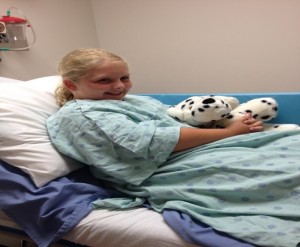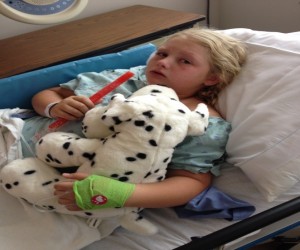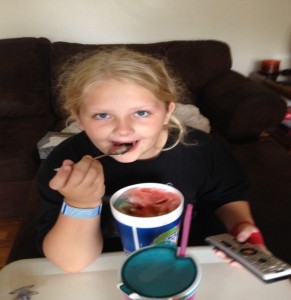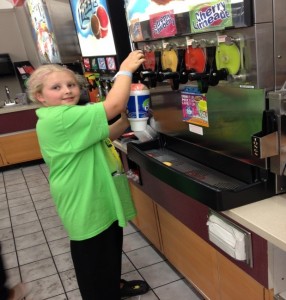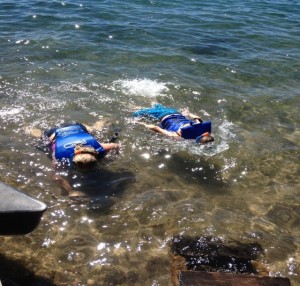By: Jen Wainwright
Parent = nurse, doctor, psychologist, chef, server, etc. We run the gamut when it comes to the roles we perform as parents. We experience stiches, broken bones, hurt fingers to hurt feelings…
That said, after a long bout with strep throat and multiple rounds and types of medicine, my nine-year-old daughter was scheduled for a tonsillectomy/adenoidectomy for July 2, 2014. Surgery (gulp). The specialist explained to us that her tonsils had more than likely become infected too deeply for medicine to reach and fully clear the infection. He also said that if her tonsils were infected, her adenoids were, too – and they both needed to be removed.
I was not in favor, per se, but I knew the surgery needed to be done. If you find yourself faced with an upcoming tonsillectomy, or know someone that is, please know this: Mama Says it’s not as bad as I feared.
Please keep in mind that a) I’m a parent, not a doctor, and b) my patient was a nine-year-old-child. I don’t know what this surgery would be like with a toddler, or an adult. If you want technical information, read that scary paperwork your pediatrician/specialist has given you, ours titled, “Care of Tonsillectomy and/or Adenoidectomy Patient”. Honestly, do read it – it will prepare you for what will likely happen, and what will more than likely NOT happen.
Then read this: I’m someone reminding you that our surgery went great, aftercare was not as bad as I feared and we had no complications. (Phew, right? I needed this article pre-surgery, and I hope it helps you in some small way…)
TIPS & TRICKS
- Bring A Stuffed Animal. Her stuffed animal was great solace for my daughter before the surgery (something to hold onto to capture the nervous energy), immediately afterwards (something to hold onto, period) and has becomes a buddy that endured something with her. Mama’s Tip: Thanks, “Tiger”.
Pre-surgery. She was kind of excited at all the attention, and kind of nervous.
- Prepare Yourself…for the moment immediately after surgery. I’ve heard from other parents that their child was disoriented, scared, even throwing up. My daughter was…well, any excited anticipation and wondering “what it would be like” pre-surgery vanished into…pain. She was scared. And in pain…and there’s nothing easy about seeing this as a parent. I mention this here because a friend who had been through the procedure mentioned it to me the week leading up to our surgery – and it helped. It prepared me. She also told me it was pretty much the worst part – and I tell you, for me, it was the worst part. And it didn’t last long.
Just after surgery, with Tiger, and 2 hours later at home. Marked improvement.
- Around the Clock Pain Medicine. Doctors prescribe varying pain medications for aftercare. Obviously, follow instructions given to you. Our specialist prescribed an antibiotic, and Tylenol/Motrin. Mama’s Tip/Trick: Set an alarm on your phone, and give the Tylenol every 4 – 6 hours and Motrin every 8 hours around the clock. I never veered from this schedule, no matter what, for the first three days – even if the time fell at 2 a.m., and the other was needed at 3 a.m. I personally believe this helped, a lot, as I believe we stayed one step ahead of any severe pain that may have occurred in the first few days.
- Fourteen Days is Long. Our doctors recommended little-to-no activity for the first week, and limited activity the second week (including no swimming! Too much jumping, playing, being rambunctious…).Let me tell you – 14 days can be really long. Movies get old. Books get boring. While I had prepared for after care foods and drinks, I know now that I underestimated how cranky and downright depressed my 9-year-old could become after being stripped of summer activity for a few days. “This surgery sucks,” came out of her mouth while staring forlornly at our pool. Mama’s Tip: Know in advance that 14 days is loooong, and while preparing liquids and soft foods and the things you “think of” for recovery – also try to plan and incorporate downtime activities for days 3 – 14 that will keep spirits up, i.e. painting together, learning to make bracelets, cooking, etc. You’ll both need these…
- Food. Pre-surgery, everyone told my child, “Just think about all the ice cream you can eat!” Except that ice cream is dairy, and heavy, and can produce excess mucous – the doctors told us to avoid it for the first 4 – 5 days. Boo. What we found worked best for the first few days were: Constant popsicles, warm soup (not hot) and noodles. And…Slurpees! It was July, and we got Slurpees twice a day for at least a week (no straw, only a spoon). This became the highlight of her day, lasted for hours upon return – and helped her avoid feeling too bummed out. Mama’s Tip/Trick: Slurpees.
One of many (many) Slurpees! She enjoyed mixing every color. This is day four of recovery, and she was well on her way to feeling pretty great.
I found that after the first few days, recovery became more about holding my child back from restricted activities than anything else. By day five, she felt like herself (with slight throat pain and ear sensitivity), and wanted to play! If I only had a quarter for every time I had to say, “Stop jumping around!” or “Don’t pick up your brother!” or “No, honey, you can’t eat popcorn for another week (one of the main no-no foods during recovery)”…
Mama Says: Tonsillectomy/Adenoidectomy is certainly surgery, no doubt, and can feel scary. But with a few tips and tricks, it’ll be over before you know it. It was for us.
Snorkeling, swimming and playing – three weeks later!
Jen is a freelance writer, parent to three, and she’s been a stepparent for over 15 years. She is well-equipped to discuss and write about the great, and the not-so-great, details of all-things-parenting. Along with spending quality time with her family, Jen enjoys music, chocolate, camping and relaxing. And laughing!


